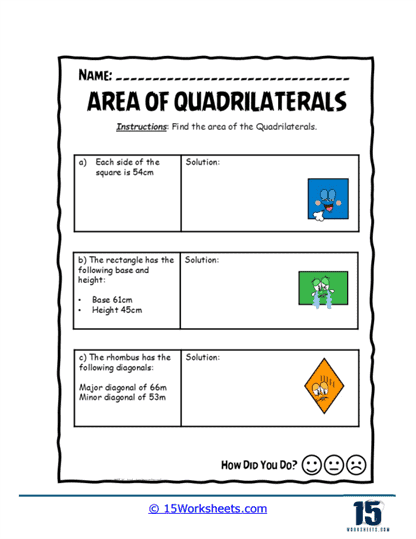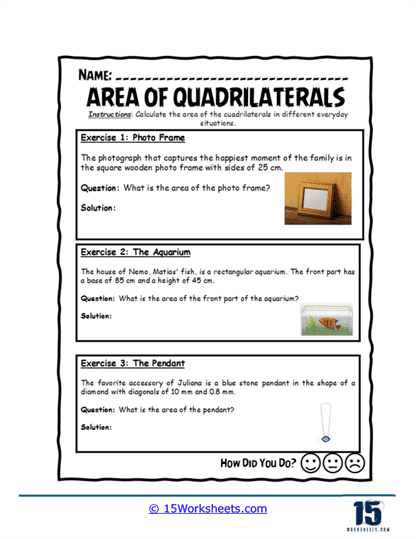Area of Quadrilaterals Worksheets
About Our Area of Quadrilaterals Worksheets
Understanding the area of quadrilaterals is a crucial skill in geometry that lays the foundation for higher-level math concepts and real-world problem-solving. This collection of geometry focused worksheets provides structured, interactive, and engaging exercises designed to help students develop a thorough understanding of how to calculate the area of various four-sided figures, including squares, rectangles, parallelograms, trapezoids, and rhombuses.
Whether you are an educator looking for supplementary materials, a parent seeking to reinforce learning at home, or a student eager to master this essential topic, these worksheets offer a comprehensive learning experience. The collection includes a diverse set of exercises, from fundamental calculations to applied problem-solving tasks, ensuring that students of all levels can confidently grasp and apply the concepts.
By working through these printable PDF worksheets, students will gain hands-on experience with geometric formulas, strengthen their analytical skills, and apply mathematical reasoning to real-world situations. This resource is designed to make learning both effective and enjoyable, helping students build confidence in their geometry skills.
Key Features and Components of the Worksheets
1. Foundation & Familiarity (Squares & Rectangles)
Worksheet: Square Quest, Notebook Math
In Square Quest, students waltz through a grid of perfectly square shapes, calculating side × side while perhaps joking about how those squares are “just rectangles with attitude.” Then, Notebook Math mixes things up with rectangles scribbled in math journals-students find themselves not only calculating area = length × width but also reflecting on how the shapes connect to their everyday “note-taking lives.” (There’s philosophical depth in those lined pages, who knew?).
2. Side-by-Side Comparison & Scaling (Rectangles, Squares, and More)
Worksheets: Bigger Shapes, Shape Size‑Up, Quadrilateral Comparisons
Here the assignment grows-literally. In Bigger Shapes, students are challenged to compare smaller and larger versions of common shapes (rectangles, squares, parallelograms), weighing the “size inflation” paradox: doubling the side doesn’t double the area-it quadruples it. Shape Size‑Up keeps the theme but spices it with irregular quadrilaterals, while Quadrilateral Comparisons tweaks mental gymnastics-“Is a 6×8 rectangle more area than a 7×7 square? And does meditating on it bring existential insight?”
3. Parallelograms & Rhombi Explorations
Worksheets: Real‑World Shapes, Quadrilateral Quest, Quadrilateral Challenge
In these, students confront shapes that tilt, skew, and challenge rectangular comfort zones. Real‑World Shapes plops quadrilaterals into real-life contexts-roof slopes, skateboard ramps-making students muse: “Is finding the safety of area akin to life’s tilted planes?” Quadrilateral Quest is an epic journey through parallelograms and rhombi, where area = base × height, complete with quests for hidden heights and secret altitudes. Quadrilateral Challenge then amps it up: missing measurements, compound problems, and meta‑reflection on “what even is a side when life (and sloped roofs) get in the way?”
4. Trapezoids Triumphant & Calculations Unleashed
Worksheets: Trapezoid Challenge, Trapezoid Trials
Enter the trapezoid stage. Trapezoid Challenge has students calculating area via average of bases × height, while practicing seating trapezoid picnics in park sketches. The tone is playful (“let’s trapezoid this trapezoid!”), but underneath, they sharpen reasoning: how does averaging bases actually capture that weird slanted world? In Trapezoid Trials, the trapezoids get trickier-angled legs, missing bases, real‑world scenarios-by the end, students are trapezoid whisperers, reflecting on “how geometry shapes our view of space… and trapezoids.”
5. Word Problems & Real-Life Integration
Worksheets: Shape Scenarios, Massive Measurements, Everyday Areas, Brick and Bill, Area Showdown
These worksheets pull students from shape study to role‑playing. Shape Scenarios plants shapes into story‑problems-“Luna built a garden bed in a trapezoid shape; how much soil does she need?”-promoting deep empathy for quadrilaterals and gardeners alike. Massive Measurements is comedic exaggeration: giant stadium floors and blimp sides-students compute gigantic areas while pondering the absurdity (“I just found the area of a whale-shaped stage!”). Everyday Areas goes emo‑realism: coffee tables, books, tabletops-students find the poetry in geometry: “the area of my phone is the canvas for my selfies.” Brick and Bill introduces anthropomorphic shapes-Brick the rectangle and Bill the rhombus-who compete in area‑baking contests. Finally, Area Showdown is the grand finale: a battle royale of quadrilaterals duking it out for “most area per perimeter,” with students as philosophical judges: is efficiency in area more valuable than stylish perimeters? These problems make students laugh, think, and ponder-“What is a quadrilateral, really?”-before cinching that final area formula.
How to Find Area of Different Quadrilaterals
Let’s break it down by type:
1. Rectangle or Square
Formula: Area = length × width
Why it works: You’re literally counting how many unit squares fit inside.
2. Parallelogram
Formula: Area = base × height
Note: The height must be perpendicular to the base-not the slanted side.
3. Trapezoid
Formula: Area = ½ × (base1 + base2) × height
Why: You’re averaging the two bases and multiplying by height. Think of it as a stretched triangle.
4. Rhombus
Formula: Area = ½ × diagonal1 × diagonal2
Why: A rhombus is made of two congruent triangles formed by diagonals.
Two Thoughtful Examples
Example 1: Finding the Area of a Parallelogram
Imagine you’re drawing a parallelogram for a flag design. The base is 10 cm, and the height (measured straight up, not along the slant) is 6 cm.
Area = base x height = 10 x 6 = 60 cm2
You’re not just calculating space; you’re ensuring the design fits, balances, and doesn’t flop in the wind. Precision matters, even in art.
Example 2: Finding the Area of a Trapezoid
Let’s say you’re laying tiles for a walkway shaped like a trapezoid. The top base is 4 ft, the bottom base is 10 ft, and the height between them is 3 ft.
Area = ½ x (4 + 10) x 3 = ½ x 14 x 3 = 7 x 3 = 21 ft2
You’re not just solving a problem; you’re deciding how many tiles to buy, how much space your path will cover, how your backyard will be shaped. Geometry becomes personal.















